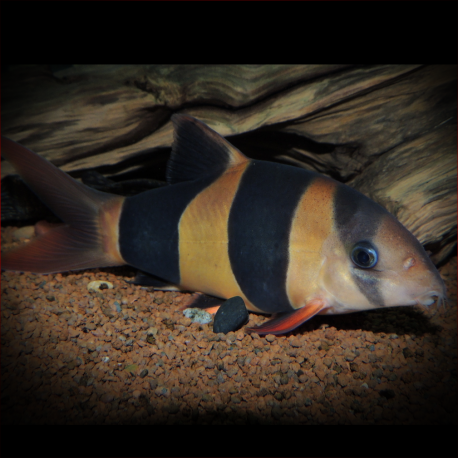More info
Datasheet
| Minimum Tank Size | 650 litres / 171.71 US gallons |
| Maximum Size | 40.0cm / 15.75inches |
| Temperature | 24°C / 75.20°F - 30°C / 86.00°F |
| Hardness | 1.01dgH / 18ppm - 12.05dgH / 215ppm |
| pH | 5.0-7.0 |
General Description
The Chromobotia Macracanthus, commonly known as the Clown Loach, is a species belonging to the family Botiidae. This striking fish species is characterized by its bright color pattern and can grow up to 40.0cm in length. Originating from the Greater Sunda Islands of Borneo and Sumatra, it exhibits slight genetic differences between the populations of these two islands, indicating potential distinct species variation.
Aquarium Setup
When setting up an aquarium for C. macracanthus, it is essential to provide a well-structured environment. A natural-style tank arrangement with elements such as sand or fine gravel substrate, smooth rocks, driftwood, and plants like Java Fern or Java Moss can create a suitable habitat. These loaches enjoy exploring and require ample cover, including rocks, wood, and ornaments. Maintaining clean, well-oxygenated water with a bit of flow is crucial for their health and necessitates regular water changes of 30-50% tank volume.
Behaviour
Clown Loaches are not overly aggressive but may intimidate smaller fish due to their size and active behavior. They fare best in groups of at least 5-6 individuals to establish social hierarchies. Social interactions are significant for these loaches, and they exhibit various behavioral rituals, including dominance displays and group swimming patterns like the "diamond formation".
Feeding and Diet
While primarily carnivorous, C. macracanthus will consume vegetative matter when available. Their diet in the wild consists of aquatic mollusks, insects, worms, and other invertebrates. In captivity, they should be offered a varied diet comprising quality dried foods, live or frozen options like bloodworms and Artemia, as well as vegetables and fruits. Special care should be taken to address any signs of "skinny disease" that may occur, especially in newly-imported specimens.
Reproduction & Dimorphism
In nature, Clown Loaches are migratory spawners, moving to smaller tributaries during the rainy season. Breeding in captivity remains rare, with attempted breeding often leading to unfertilized eggs. Sexual dimorphism includes adult females being fuller-bodied and larger than males. Specimens typically reach sexual maturity around 120-150 mm in size, with larger individuals potentially foregoing annual spawning migrations.
Habitat and Distribution
The natural habitat of C. macracanthus primarily includes main river channels and temporarily flooded areas during the wet season. Native to the river systems of Kalimantan and Sumatra, this species is found in regions with soft, tea-colored water and lush rainforest surroundings. It thrives in environments with diverse fish species, demonstrating adaptability to varying water conditions and habitat types.
Etymology: The genus name Chromobotia is derived from the Greek word "khroma," meaning color, in reference to the species' bright coloration.

